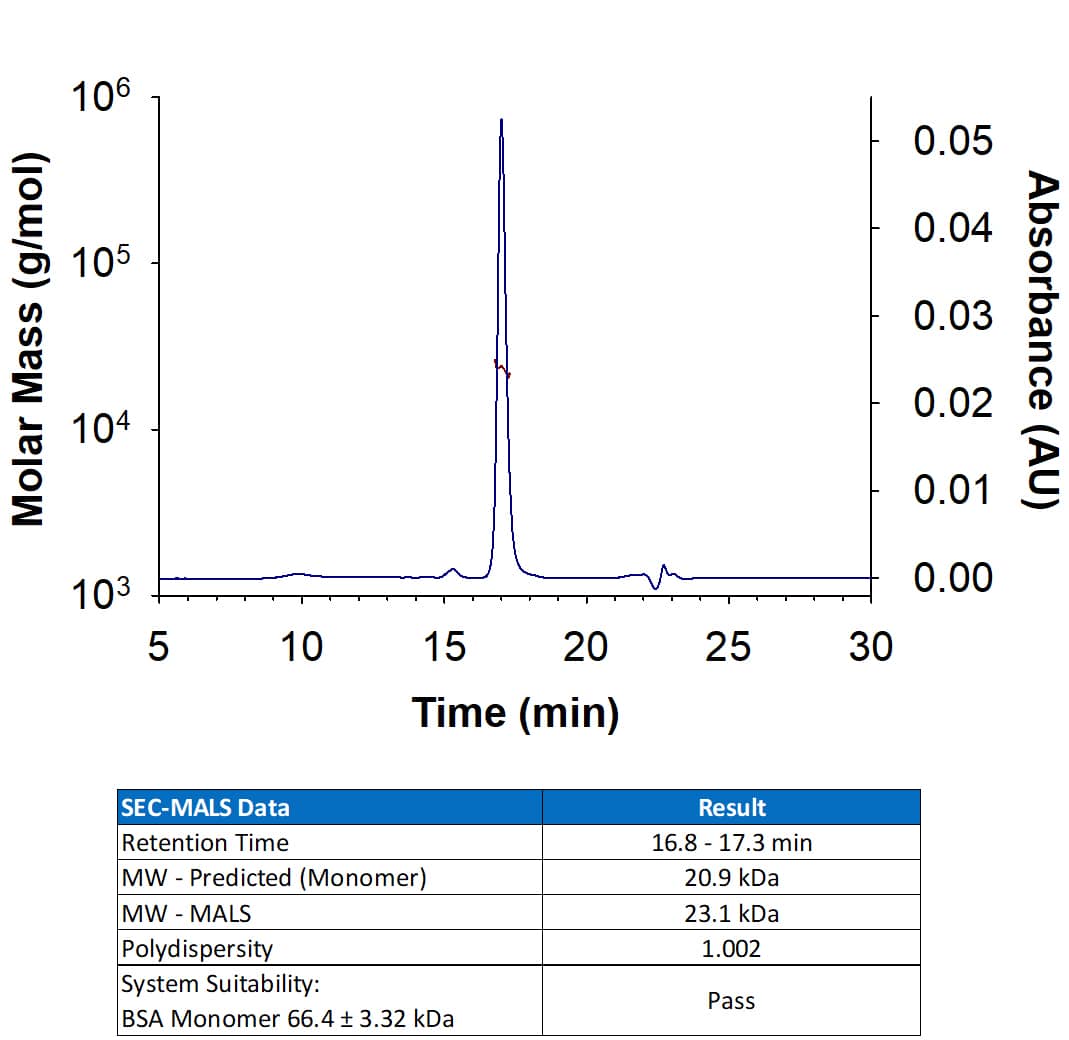Recombinant Mouse Legumain/Asparaginyl Endopeptidase, CF
Recombinant Mouse Legumain/Asparaginyl Endopeptidase, CF Summary
Product Specifications
Val18-Tyr435, with an N-terminal 7-His tag
Analysis
Customers also Viewed
Product Datasheets
Carrier Free
CF stands for Carrier Free (CF). We typically add Bovine Serum Albumin (BSA) as a carrier protein to our recombinant proteins. Adding a carrier protein enhances protein stability, increases shelf-life, and allows the recombinant protein to be stored at a more dilute concentration. The carrier free version does not contain BSA.
In general, we advise purchasing the recombinant protein with BSA for use in cell or tissue culture, or as an ELISA standard. In contrast, the carrier free protein is recommended for applications, in which the presence of BSA could interfere.
2058-CY
| Formulation | Supplied as a 0.2 μm filtered solution in Tris, NaCl and Glycerol. |
| Shipping | The product is shipped with dry ice or equivalent. Upon receipt, store it immediately at the temperature recommended below. |
| Stability & Storage: | Use a manual defrost freezer and avoid repeated freeze-thaw cycles.
|
Assay Procedure
- Activation Buffer: 0.1 M NaOAc, 0.1 M NaCl, pH 4.5
- Assay Buffer: 50 mM MES, 250 mM NaCl, pH 5.5
- Recombinant Mouse Legumain/Asparaginyl Endopeptidase (rmLegumain) (Catalog # 2058-CY)
- Substrate: Z-Ala-Ala-Asn-AMC (Bachem, Catalog # I-1865), 10 mM stock in DMSO
- F16 Black Maxisorp Plate (Nunc, Catalog # 475515)
- Fluorescent Plate Reader (Model: SpectraMax Gemini EM by Molecular Devices) or equivalent
- Dilute rmLegumain to 50 µg/mL in Activation Buffer.
- Incubate for 4 hours at 37 °C.
- Dilute rmLegumain to 2 ng/µL in Assay Buffer.
- Dilute Substrate to 200 µM in Assay Buffer.
- Load 50 µL of 2 ng/µL rmLegumain in the plate, and start the reaction by adding 50 µL of 200 µM Substrate. Include a Substrate Blank containing Assay Buffer and Substrate.
- Read at excitation and emission wavelengths of 380 nm and 460 nm (top read), respectively, in kinetic mode for 5 minutes.
- Calculate specific activity:
|
Specific Activity (pmol/min/µg) = |
Adjusted Vmax* (RFU/min) x Conversion Factor** (pmol/RFU) |
| amount of enzyme (µg) |
*Adjusted for Substrate Blank
**Derived using calibration standard 7-Amino, 4-Methyl Coumarin (AMC) (Sigma, Catalog # A-9891).
Per Well:- rmLegumain: 0.100 µg
- Substrate: 100 µM
Background: Legumain/Asparaginyl Endopeptidase
Legumain is a lysosomal cysteine protease found in all mouse tissues examined, but was particularly abundant in kidney and placenta (1). Legumain plays a pivotal role in the endosomal/lysosomal degradation system because the Legumain deficiency causes the accumulation of pro cathepsins B, H and L, another group of lysosomal cysteine proteases (2). Over-expression of Legumain in tumors is significant for invasion/metastasis (3). Also known as asparaginyl endopeptidase, it specifically cleaves peptide bonds with Asn at the P1 position. Nevertheless, it also cleaves peptide bonds with Asp at the P1 position. Auto-activation of pro Legumain involves both types of cleavage, which results in the removal of the pro peptides in both C- and N-termini (4). In addition, Legumain activates pro MMP-2 and processes bacterial antigens for MHC class II presentation and pro thymosin alpha to thymosin alpha 1 and thymosin alpha 11, two acidic peptides with immunoregulatory properties (5-7). Mouse Legumain is synthesized as a 435 amino acid precursor with a signal peptide (residues 1 to 17). The pro enzyme (residues 18 to 435) was expressed with an N-terminal His tag. The purified pro enzyme can be activated under the conditions as described above. Legumain activity can be inhibited by rmCystatin C and recombinant human cystatins C and E/M (Catalog # 1238-PI, 1196-PI, and 1286-PI).
- Chen, J.M. et al. (1998) Biochem. J. 335:111.
- Shirahama-Noda, K. et al. (2003) J. Biol. Chem. 278:33194.
- Liu, C. et al. (2003) Cancer Res. 63: 2957.
- Li D.N. et al. (2003) J. Biol. Chem. 278:38980.
- Chen, J.M. et al. (2001) Biol. Chem. 382:777.
- Schwarz, G. et al. (2002) Biol. Chem. 383:1813.
- Sarndeses, C.S. et al. (2003) J. Biol. Chem. 278:13286.
Citations for Recombinant Mouse Legumain/Asparaginyl Endopeptidase, CF
R&D Systems personnel manually curate a database that contains references using R&D Systems products. The data collected includes not only links to publications in PubMed, but also provides information about sample types, species, and experimental conditions.
2
Citations: Showing 1 - 2
Filter your results:
Filter by:
-
Towards imaging the immune state of cancer by PET: Targeting legumain with 11C-labeled P1-Asn peptidomimetics carrying a cyano-warhead
Authors: Lustenberger, SK;Castro Jaramillo, CA;Bärtschi, LA;Williams, R;Schibli, R;Mu, L;Krämer, SD;
Nuclear medicine and biology
Species: N/A
Sample Types: Fluorogenic Peptide Substrate
Applications: Bioassay -
Pharmacological Inhibition of the Asparaginyl Endopeptidase (AEP) in an Alzheimer's Disease Model Improves the Survival and Efficacy of Transplanted Neural Stem Cells
Authors: Cheng, Q;Ma, X;Liu, J;Feng, X;Liu, Y;Wang, Y;Ni, W;Song, M;
International journal of molecular sciences
Species: Mouse
Sample Types: Recombinant Protein
Applications: Bioassay
FAQs
No product specific FAQs exist for this product, however you may
View all Proteins and Enzyme FAQsReviews for Recombinant Mouse Legumain/Asparaginyl Endopeptidase, CF
There are currently no reviews for this product. Be the first to review Recombinant Mouse Legumain/Asparaginyl Endopeptidase, CF and earn rewards!
Have you used Recombinant Mouse Legumain/Asparaginyl Endopeptidase, CF?
Submit a review and receive an Amazon gift card.
$25/€18/£15/$25CAN/¥75 Yuan/¥2500 Yen for a review with an image
$10/€7/£6/$10 CAD/¥70 Yuan/¥1110 Yen for a review without an image










